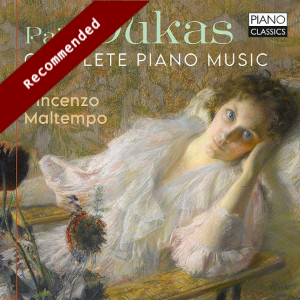
Paul Dukas (1865-1935)
Piano Sonata in E flat minor (1899-1900)
Variations, interlude et finale sur un thème de Rameau (1899-1902)
Prelude élégiaque sur like nom de Haydn (1909)
La Plainte, au loin, du faune… (1920)
Vincenzo Maltempo (piano)
rec. 2022, Westvest Church, Schiedam, The Netherlands
Piano Classics PCL10171 [74]
Most music lovers might only know French composer, critic and teacher Paul Dukas for one work, and so treat him as a “one-hit wonder”. Indeed, there can be precious few folk who do not know The Sorcerer’s Apprentice, at least in its Walt Disney incarnation. Well, opera devotees may have come across his Ariane et Barbe-bleue. Sadly, his catalogue is surprisingly small. A fastidious composer, he destroyed many of his works. There remain a “charming and colourful” Symphony and La Péri, a ballet score. Fortunately, he created one of the most impressive and important piano sonatas in the repertoire of French music. Also for the piano, there are the remarkable Rameau Variations and a handful of miniatures.
The main event on this programme is the massive four-movement Piano Sonata. The liner notes suggest that it is a sort of French Hammerklavier, which is manifested in its “colossal dimensions, its structural complexities and its tightrope virtuoso writing”. Yet what dominates this score is not the German master per se but “Beethoven as he was interpreted to the French mind by César Franck”. The music of Charles-Valentin Alkan may also be an influence; Franz Liszt certainly is. Despite its “classical” constructs, the Sonata was highly praised by Claude Debussy, who at the turn of the century was moving toward impressionism. The piece travels from the home key of E flat minor to E flat major in the finale. There are hints of Liszt/Franck cyclic procedures in the last movement, as Dukas echoes the opening theme.
Pianist James Gibb summed up the Sonata’s aesthetic: “The grandeur and piano style owe much to Franck, but there is a more pleasing clarity of texture, and the sequences neither cloy or meander.” Vincenzo Maltempo gives an exhilarating performance.
Variations, interlude, et finale sur un thème de Rameau is a delightful confection, which entertains and satisfies. Composer and musicologist Norman Demuth has suggested that Rameau’s little minuet is only a “mere peg upon which to hang music with seemingly little relationship to it”. That said, one of the principles of variation writing can be to “conceal the theme as far as possible, even to the extent of excluding it altogether or including it by implication and suggestion”. These eleven short variations are subtle and interesting, with lots of contrast. The Interlude, highly dramatic and virtuosic, has moments of calm too. Interestingly, although Rameau’s theme does make a reappearance in the Finale, it is not triumphant but subtly altered and restated.
Six well-known and hugely respected composers contributed to a collection of pieces to commemorate in 1909 the centenary of the death of Joseph Haydn: Debussy, Ravel, D’Indy, Hahn, Widor and Dukas. The latter offered Prelude élégiaque sur le nom de Haydn. Like the others, it was based on a theme derived from the elder composer’s name transcribed into notes (B-A-D-D-G). This impressionistic piece reflects Dukas’s friendship with Debussy. It presents ever-increasingly strange harmonies and innovative modulations. Maltempo creates an elegiac mood of stasis that reflects the “thematic juxtapositions that freely flow and eventually dissolve”.
La Plainte, au loin, du faune… (Lament, from afar, of the faun) is another short number. It was a response to a call by Henry Prunières (1886-1942), the director of the French journal La revue musicale, for pieces to be included in Le Tombeau de Claude Debussy. That publication was to commemorate the achievements of Debussy, who had died on 25 March 1918. Ten composers stepped up to the plate, including Ravel, Roussel, de Falla, Goossens and Bartók. Dukas’s piece acts as a commentary on Debussy’s Prélude à l’après-midi d’un faune. Some of the harmonies and gently unfolding melodies not only looks back to the French master but seem to anticipate Dukas’s pupil Olivier Messiaen’s musical technique. The performance here highlights the almost surrealistic mood which this magical piece creates.
One final point: I understand there is a short unpublished Modère for piano which could have been included for completeness. I am not sure of its availability.
Peter Quantrill’s helpful liner notes give details about Dukas and his music. There is a profile of the soloist Vincenzo Maltempo, and there is more at his outstanding website. Suffice to say that he has made a number of recordings, including Scriabin’s complete Sonatas and an ongoing edition of Alkan’s piano works. The evocative cover picture is Catherine La Rose by the Symbolist artist Armand Point (1860-1932).
I have not had the opportunity of hearing other accounts of Dukas’s piano music. There are certainly lots to explore. These include, but are not limited to, Marc-André Hamelin on Hyperion, Hervé Billaut on Mirare, Margaret Fingerhut on Chandos, and Tor Espen Aspaas on Simax.
This is a remarkable album to which I will return. The Sonata is clearly a masterpiece, and one which ought to be explored in greater detail, both with and without the score in hand. Critically, it is regarded as one of the 20th century’s finest examples of the genre. Yet, it is rarely heard in the concert hall due to its technical difficulties and 45-minute duration. Vincenzo Maltempo has made a superlative recording of this significant, highly charged and intellectually demanding work. It captures the romantic sweep of the music and its nuances. Equally absorbing are the performances of the other three works on this disc.
John France
Help us financially by purchasing from





















